FINANCE 10: Corporate and Financial Accounting Equity and Liabilities
VerifiedAdded on 2022/11/17
|16
|2769
|210
Report
AI Summary
This report delves into the concepts of equity and liabilities within corporate and financial accounting. It examines the fluctuations in equity and liabilities over a three-year period, focusing on the ANZ Bank and Commonwealth Bank. The report is divided into two parts: Part A analyzes equity and liabilities, including ordinary share capital, retained earnings, and non-controlling interests. It also covers key items reported under liabilities, such as deposits, payables, and debt issues. Part B discusses the characteristics and compliance requirements of small and large proprietary companies, along with the concept of a reporting entity. The analysis includes the advantages of debt, equity, and cash equivalents as funding sources. The report highlights key financial aspects, providing insights into the financial positions of the companies and the importance of financial reporting for understanding the business's performance. The report concludes with a summary of the findings and their implications.

Corporate and Financial Accounting
Paraphrase This Document
Need a fresh take? Get an instant paraphrase of this document with our AI Paraphraser
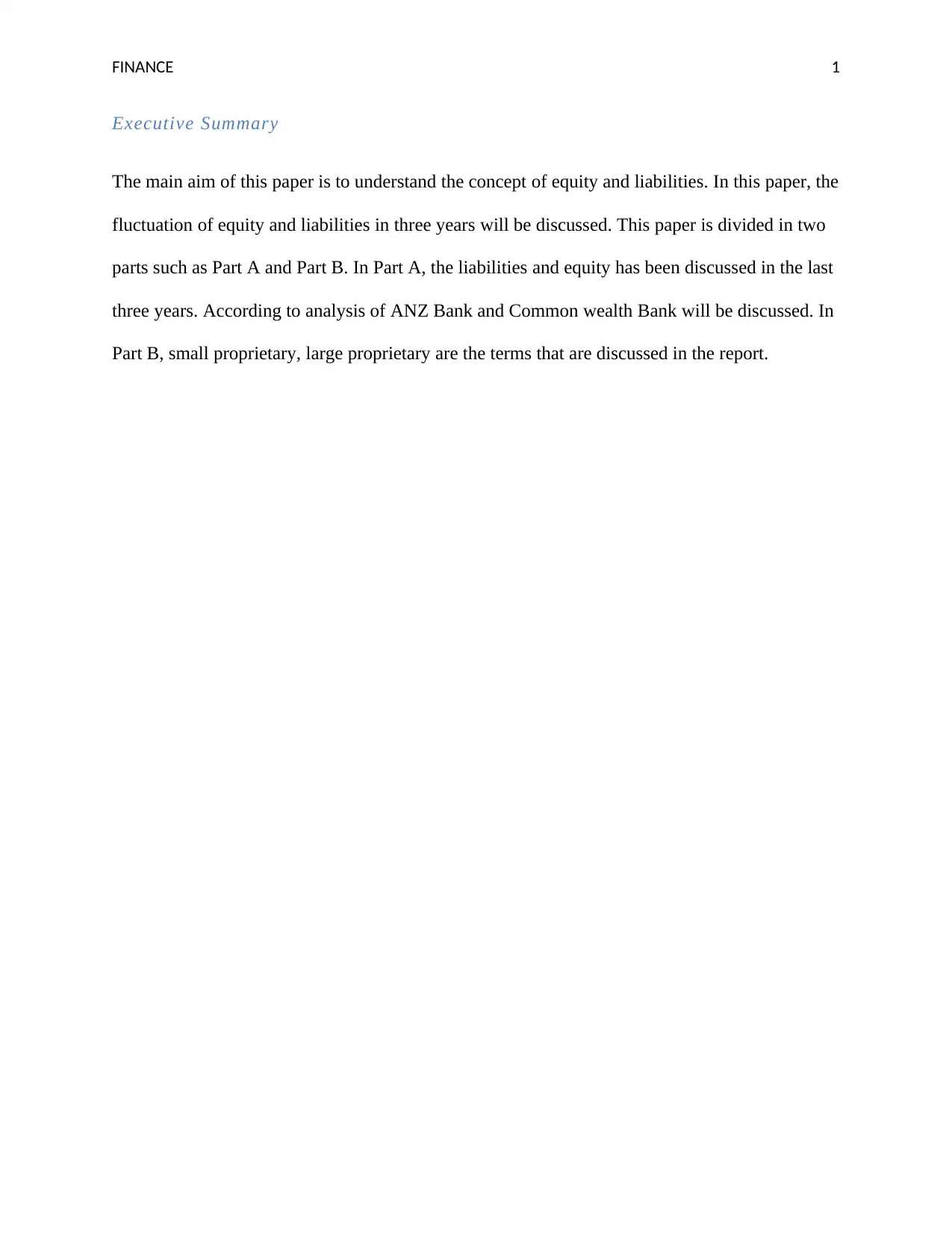
FINANCE 1
Executive Summary
The main aim of this paper is to understand the concept of equity and liabilities. In this paper, the
fluctuation of equity and liabilities in three years will be discussed. This paper is divided in two
parts such as Part A and Part B. In Part A, the liabilities and equity has been discussed in the last
three years. According to analysis of ANZ Bank and Common wealth Bank will be discussed. In
Part B, small proprietary, large proprietary are the terms that are discussed in the report.
Executive Summary
The main aim of this paper is to understand the concept of equity and liabilities. In this paper, the
fluctuation of equity and liabilities in three years will be discussed. This paper is divided in two
parts such as Part A and Part B. In Part A, the liabilities and equity has been discussed in the last
three years. According to analysis of ANZ Bank and Common wealth Bank will be discussed. In
Part B, small proprietary, large proprietary are the terms that are discussed in the report.
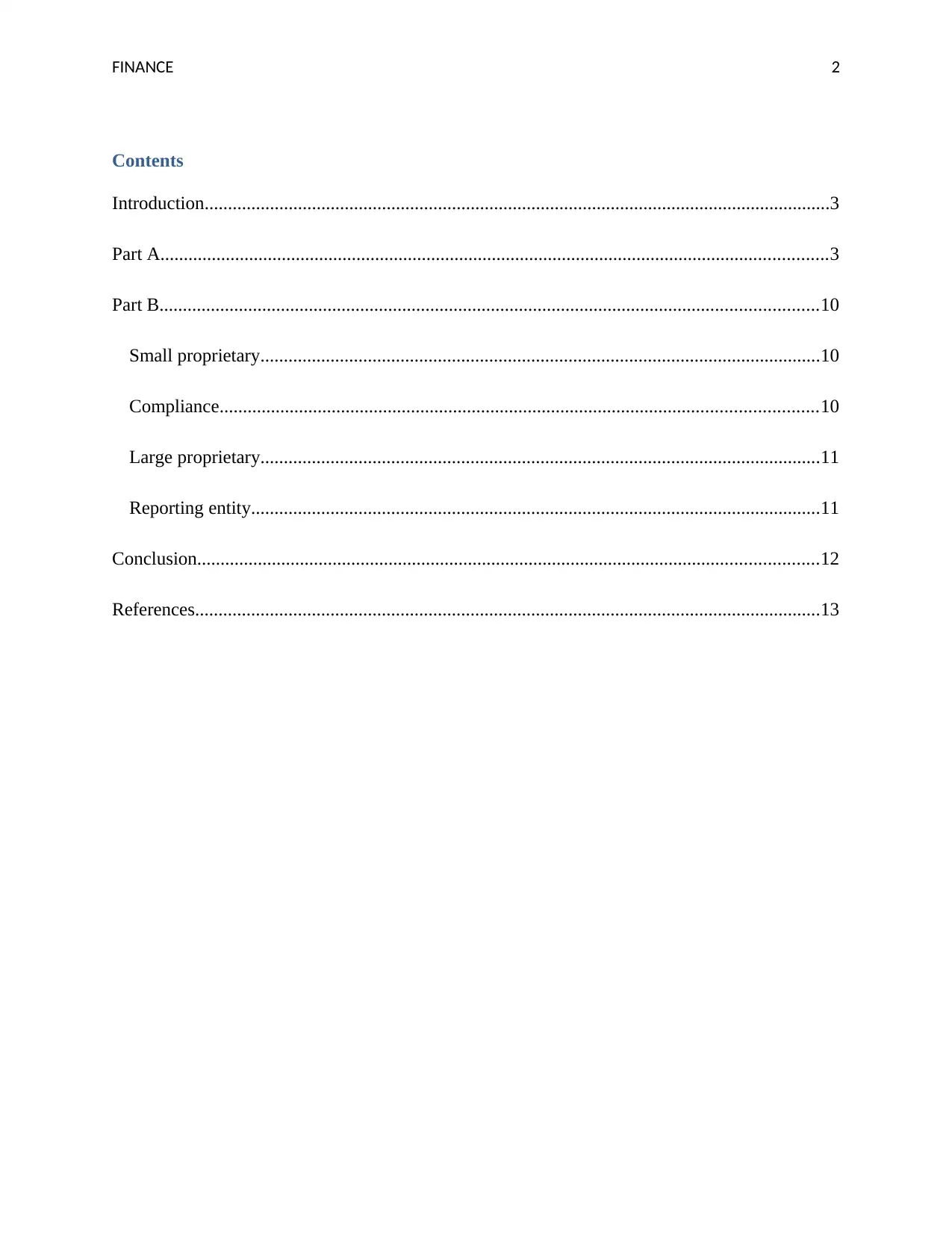
FINANCE 2
Contents
Introduction......................................................................................................................................3
Part A...............................................................................................................................................3
Part B.............................................................................................................................................10
Small proprietary........................................................................................................................10
Compliance................................................................................................................................10
Large proprietary........................................................................................................................11
Reporting entity..........................................................................................................................11
Conclusion.....................................................................................................................................12
References......................................................................................................................................13
Contents
Introduction......................................................................................................................................3
Part A...............................................................................................................................................3
Part B.............................................................................................................................................10
Small proprietary........................................................................................................................10
Compliance................................................................................................................................10
Large proprietary........................................................................................................................11
Reporting entity..........................................................................................................................11
Conclusion.....................................................................................................................................12
References......................................................................................................................................13
⊘ This is a preview!⊘
Do you want full access?
Subscribe today to unlock all pages.

Trusted by 1+ million students worldwide
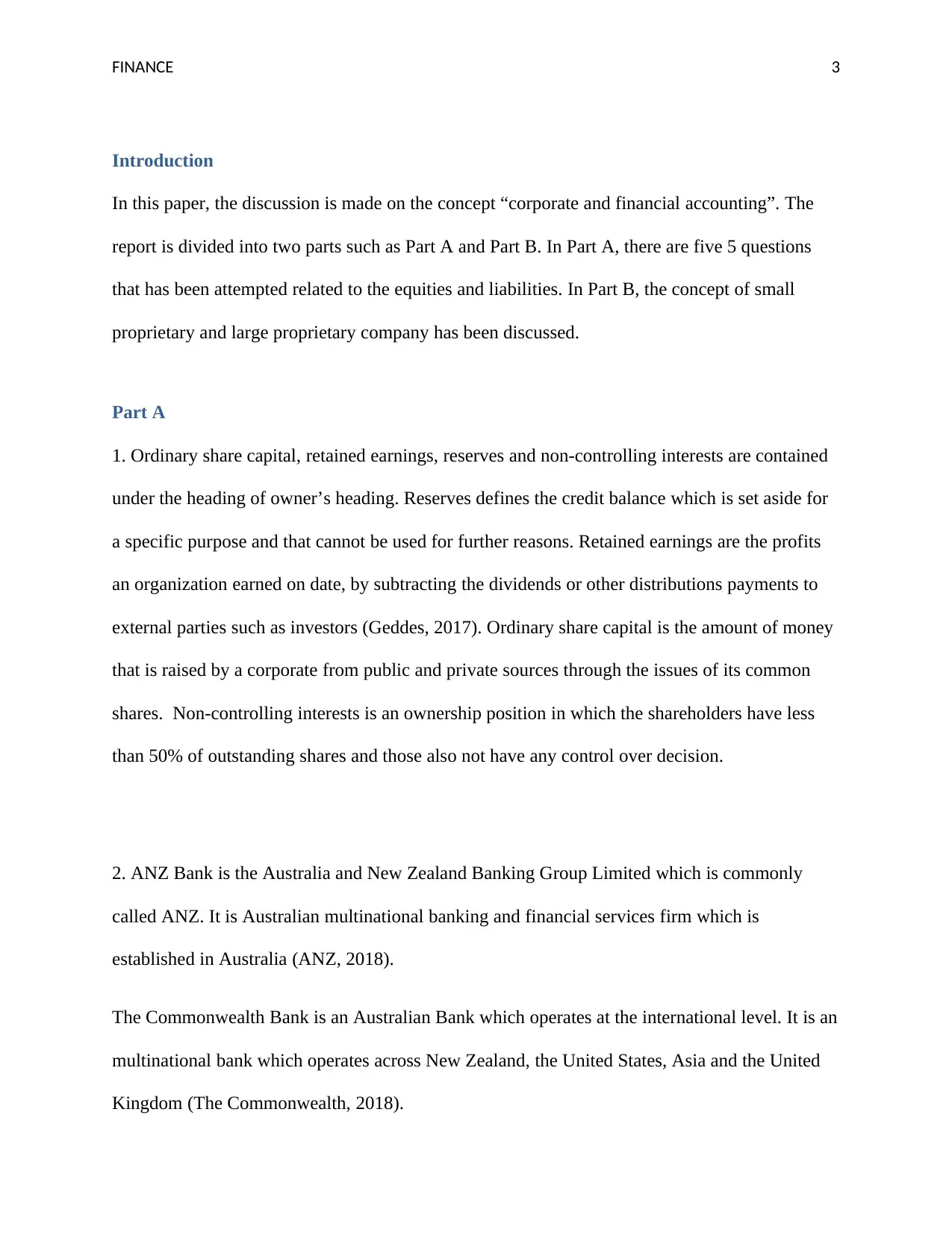
FINANCE 3
Introduction
In this paper, the discussion is made on the concept “corporate and financial accounting”. The
report is divided into two parts such as Part A and Part B. In Part A, there are five 5 questions
that has been attempted related to the equities and liabilities. In Part B, the concept of small
proprietary and large proprietary company has been discussed.
Part A
1. Ordinary share capital, retained earnings, reserves and non-controlling interests are contained
under the heading of owner’s heading. Reserves defines the credit balance which is set aside for
a specific purpose and that cannot be used for further reasons. Retained earnings are the profits
an organization earned on date, by subtracting the dividends or other distributions payments to
external parties such as investors (Geddes, 2017). Ordinary share capital is the amount of money
that is raised by a corporate from public and private sources through the issues of its common
shares. Non-controlling interests is an ownership position in which the shareholders have less
than 50% of outstanding shares and those also not have any control over decision.
2. ANZ Bank is the Australia and New Zealand Banking Group Limited which is commonly
called ANZ. It is Australian multinational banking and financial services firm which is
established in Australia (ANZ, 2018).
The Commonwealth Bank is an Australian Bank which operates at the international level. It is an
multinational bank which operates across New Zealand, the United States, Asia and the United
Kingdom (The Commonwealth, 2018).
Introduction
In this paper, the discussion is made on the concept “corporate and financial accounting”. The
report is divided into two parts such as Part A and Part B. In Part A, there are five 5 questions
that has been attempted related to the equities and liabilities. In Part B, the concept of small
proprietary and large proprietary company has been discussed.
Part A
1. Ordinary share capital, retained earnings, reserves and non-controlling interests are contained
under the heading of owner’s heading. Reserves defines the credit balance which is set aside for
a specific purpose and that cannot be used for further reasons. Retained earnings are the profits
an organization earned on date, by subtracting the dividends or other distributions payments to
external parties such as investors (Geddes, 2017). Ordinary share capital is the amount of money
that is raised by a corporate from public and private sources through the issues of its common
shares. Non-controlling interests is an ownership position in which the shareholders have less
than 50% of outstanding shares and those also not have any control over decision.
2. ANZ Bank is the Australia and New Zealand Banking Group Limited which is commonly
called ANZ. It is Australian multinational banking and financial services firm which is
established in Australia (ANZ, 2018).
The Commonwealth Bank is an Australian Bank which operates at the international level. It is an
multinational bank which operates across New Zealand, the United States, Asia and the United
Kingdom (The Commonwealth, 2018).
Paraphrase This Document
Need a fresh take? Get an instant paraphrase of this document with our AI Paraphraser
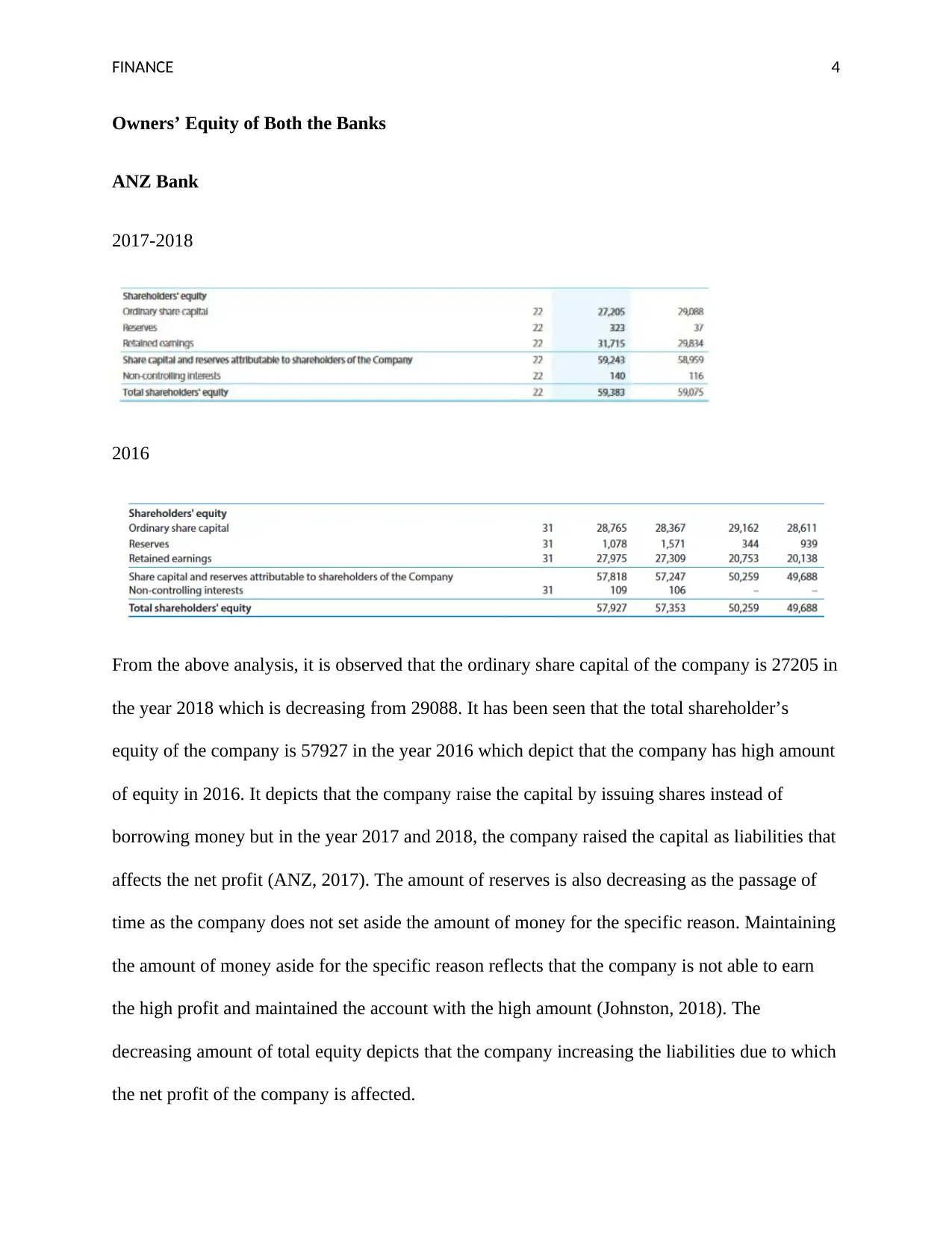
FINANCE 4
Owners’ Equity of Both the Banks
ANZ Bank
2017-2018
2016
From the above analysis, it is observed that the ordinary share capital of the company is 27205 in
the year 2018 which is decreasing from 29088. It has been seen that the total shareholder’s
equity of the company is 57927 in the year 2016 which depict that the company has high amount
of equity in 2016. It depicts that the company raise the capital by issuing shares instead of
borrowing money but in the year 2017 and 2018, the company raised the capital as liabilities that
affects the net profit (ANZ, 2017). The amount of reserves is also decreasing as the passage of
time as the company does not set aside the amount of money for the specific reason. Maintaining
the amount of money aside for the specific reason reflects that the company is not able to earn
the high profit and maintained the account with the high amount (Johnston, 2018). The
decreasing amount of total equity depicts that the company increasing the liabilities due to which
the net profit of the company is affected.
Owners’ Equity of Both the Banks
ANZ Bank
2017-2018
2016
From the above analysis, it is observed that the ordinary share capital of the company is 27205 in
the year 2018 which is decreasing from 29088. It has been seen that the total shareholder’s
equity of the company is 57927 in the year 2016 which depict that the company has high amount
of equity in 2016. It depicts that the company raise the capital by issuing shares instead of
borrowing money but in the year 2017 and 2018, the company raised the capital as liabilities that
affects the net profit (ANZ, 2017). The amount of reserves is also decreasing as the passage of
time as the company does not set aside the amount of money for the specific reason. Maintaining
the amount of money aside for the specific reason reflects that the company is not able to earn
the high profit and maintained the account with the high amount (Johnston, 2018). The
decreasing amount of total equity depicts that the company increasing the liabilities due to which
the net profit of the company is affected.
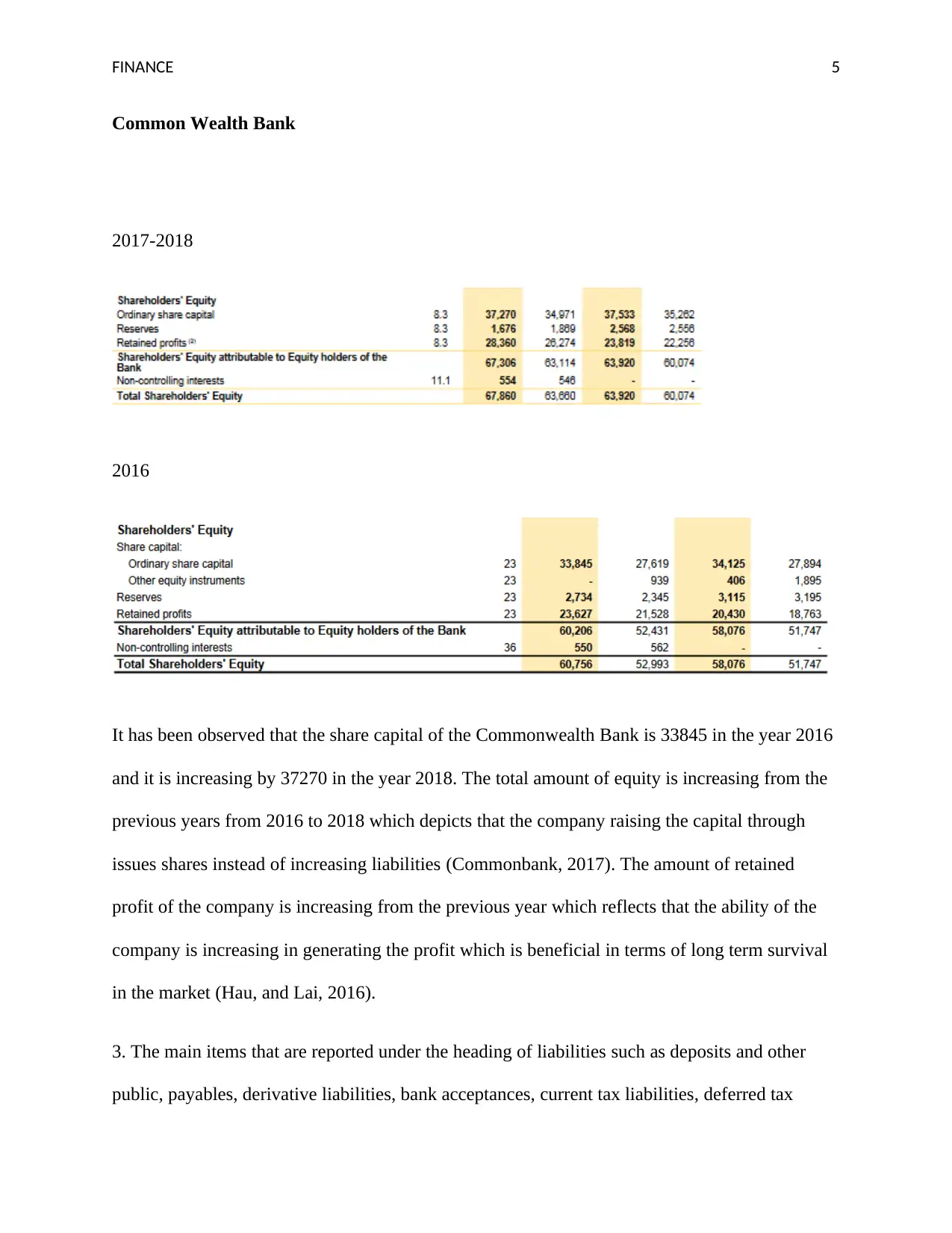
FINANCE 5
Common Wealth Bank
2017-2018
2016
It has been observed that the share capital of the Commonwealth Bank is 33845 in the year 2016
and it is increasing by 37270 in the year 2018. The total amount of equity is increasing from the
previous years from 2016 to 2018 which depicts that the company raising the capital through
issues shares instead of increasing liabilities (Commonbank, 2017). The amount of retained
profit of the company is increasing from the previous year which reflects that the ability of the
company is increasing in generating the profit which is beneficial in terms of long term survival
in the market (Hau, and Lai, 2016).
3. The main items that are reported under the heading of liabilities such as deposits and other
public, payables, derivative liabilities, bank acceptances, current tax liabilities, deferred tax
Common Wealth Bank
2017-2018
2016
It has been observed that the share capital of the Commonwealth Bank is 33845 in the year 2016
and it is increasing by 37270 in the year 2018. The total amount of equity is increasing from the
previous years from 2016 to 2018 which depicts that the company raising the capital through
issues shares instead of increasing liabilities (Commonbank, 2017). The amount of retained
profit of the company is increasing from the previous year which reflects that the ability of the
company is increasing in generating the profit which is beneficial in terms of long term survival
in the market (Hau, and Lai, 2016).
3. The main items that are reported under the heading of liabilities such as deposits and other
public, payables, derivative liabilities, bank acceptances, current tax liabilities, deferred tax
⊘ This is a preview!⊘
Do you want full access?
Subscribe today to unlock all pages.

Trusted by 1+ million students worldwide
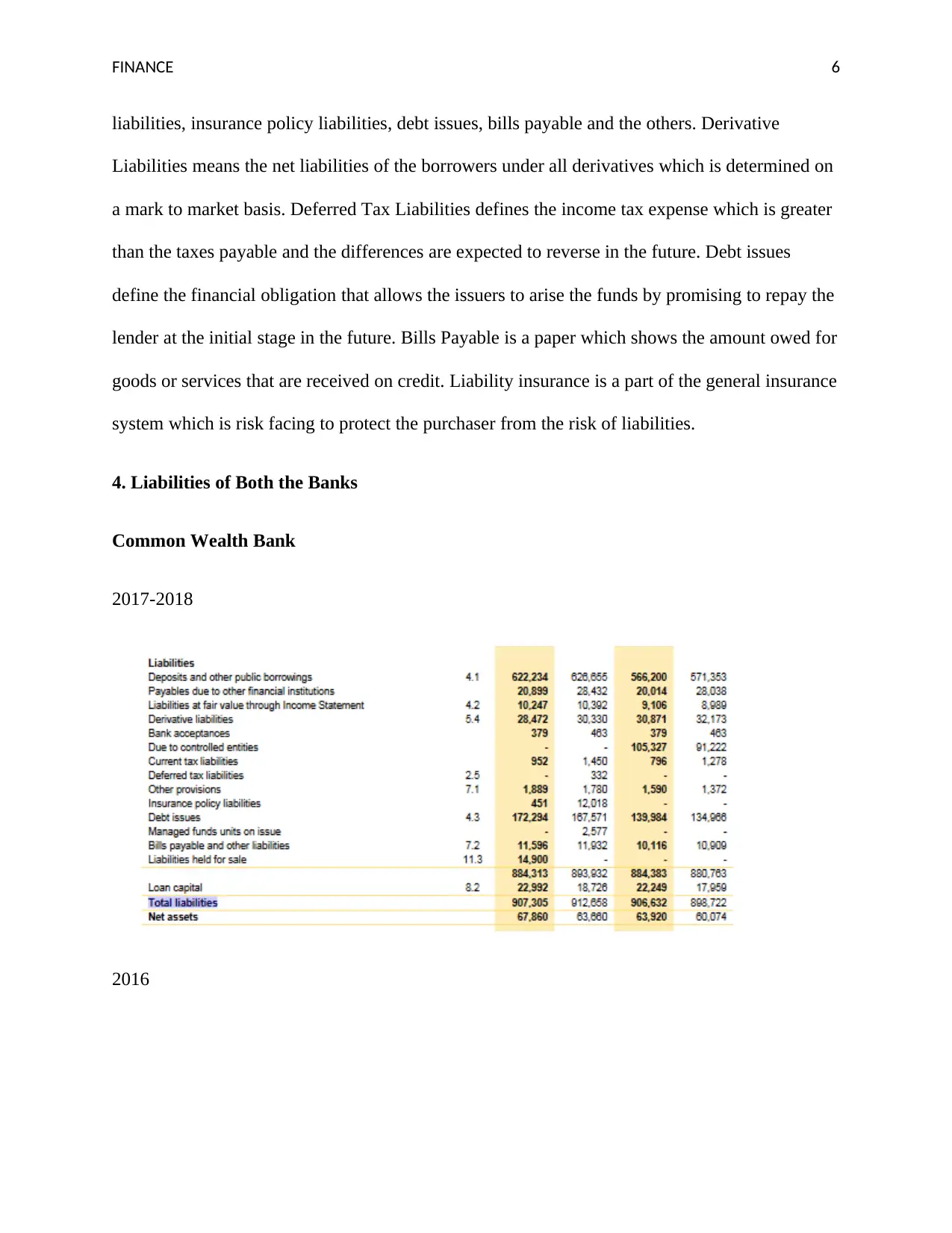
FINANCE 6
liabilities, insurance policy liabilities, debt issues, bills payable and the others. Derivative
Liabilities means the net liabilities of the borrowers under all derivatives which is determined on
a mark to market basis. Deferred Tax Liabilities defines the income tax expense which is greater
than the taxes payable and the differences are expected to reverse in the future. Debt issues
define the financial obligation that allows the issuers to arise the funds by promising to repay the
lender at the initial stage in the future. Bills Payable is a paper which shows the amount owed for
goods or services that are received on credit. Liability insurance is a part of the general insurance
system which is risk facing to protect the purchaser from the risk of liabilities.
4. Liabilities of Both the Banks
Common Wealth Bank
2017-2018
2016
liabilities, insurance policy liabilities, debt issues, bills payable and the others. Derivative
Liabilities means the net liabilities of the borrowers under all derivatives which is determined on
a mark to market basis. Deferred Tax Liabilities defines the income tax expense which is greater
than the taxes payable and the differences are expected to reverse in the future. Debt issues
define the financial obligation that allows the issuers to arise the funds by promising to repay the
lender at the initial stage in the future. Bills Payable is a paper which shows the amount owed for
goods or services that are received on credit. Liability insurance is a part of the general insurance
system which is risk facing to protect the purchaser from the risk of liabilities.
4. Liabilities of Both the Banks
Common Wealth Bank
2017-2018
2016
Paraphrase This Document
Need a fresh take? Get an instant paraphrase of this document with our AI Paraphraser
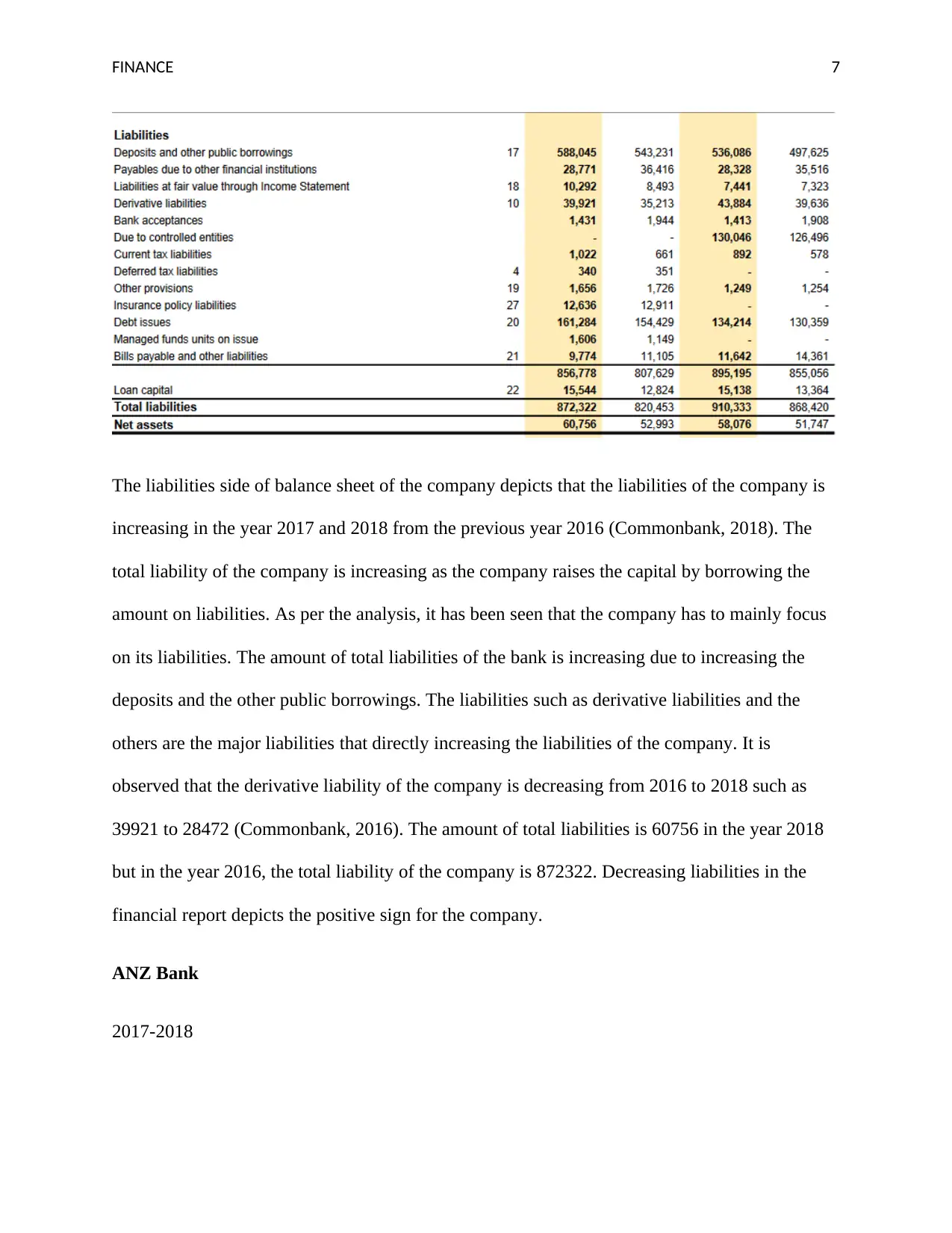
FINANCE 7
The liabilities side of balance sheet of the company depicts that the liabilities of the company is
increasing in the year 2017 and 2018 from the previous year 2016 (Commonbank, 2018). The
total liability of the company is increasing as the company raises the capital by borrowing the
amount on liabilities. As per the analysis, it has been seen that the company has to mainly focus
on its liabilities. The amount of total liabilities of the bank is increasing due to increasing the
deposits and the other public borrowings. The liabilities such as derivative liabilities and the
others are the major liabilities that directly increasing the liabilities of the company. It is
observed that the derivative liability of the company is decreasing from 2016 to 2018 such as
39921 to 28472 (Commonbank, 2016). The amount of total liabilities is 60756 in the year 2018
but in the year 2016, the total liability of the company is 872322. Decreasing liabilities in the
financial report depicts the positive sign for the company.
ANZ Bank
2017-2018
The liabilities side of balance sheet of the company depicts that the liabilities of the company is
increasing in the year 2017 and 2018 from the previous year 2016 (Commonbank, 2018). The
total liability of the company is increasing as the company raises the capital by borrowing the
amount on liabilities. As per the analysis, it has been seen that the company has to mainly focus
on its liabilities. The amount of total liabilities of the bank is increasing due to increasing the
deposits and the other public borrowings. The liabilities such as derivative liabilities and the
others are the major liabilities that directly increasing the liabilities of the company. It is
observed that the derivative liability of the company is decreasing from 2016 to 2018 such as
39921 to 28472 (Commonbank, 2016). The amount of total liabilities is 60756 in the year 2018
but in the year 2016, the total liability of the company is 872322. Decreasing liabilities in the
financial report depicts the positive sign for the company.
ANZ Bank
2017-2018
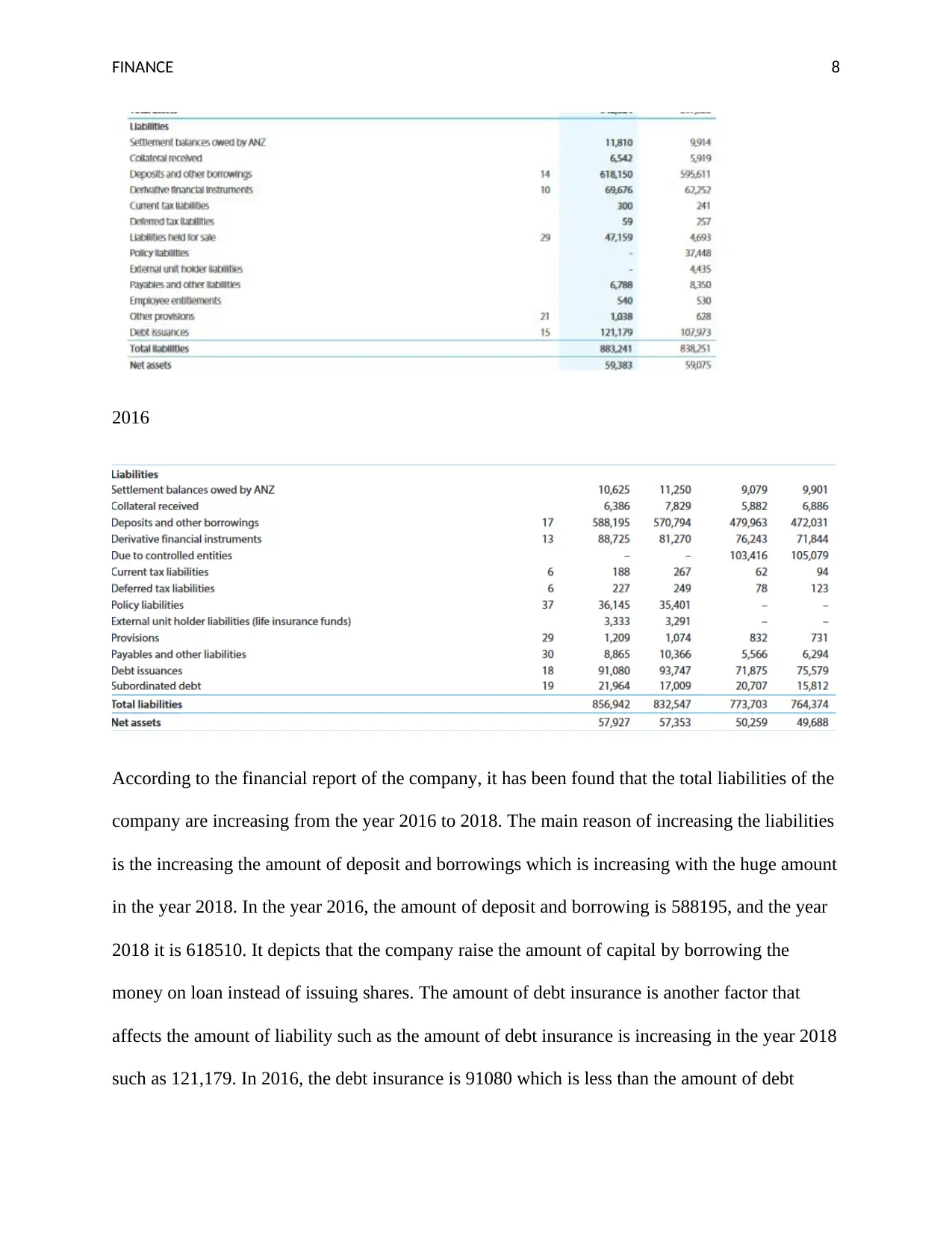
FINANCE 8
2016
According to the financial report of the company, it has been found that the total liabilities of the
company are increasing from the year 2016 to 2018. The main reason of increasing the liabilities
is the increasing the amount of deposit and borrowings which is increasing with the huge amount
in the year 2018. In the year 2016, the amount of deposit and borrowing is 588195, and the year
2018 it is 618510. It depicts that the company raise the amount of capital by borrowing the
money on loan instead of issuing shares. The amount of debt insurance is another factor that
affects the amount of liability such as the amount of debt insurance is increasing in the year 2018
such as 121,179. In 2016, the debt insurance is 91080 which is less than the amount of debt
2016
According to the financial report of the company, it has been found that the total liabilities of the
company are increasing from the year 2016 to 2018. The main reason of increasing the liabilities
is the increasing the amount of deposit and borrowings which is increasing with the huge amount
in the year 2018. In the year 2016, the amount of deposit and borrowing is 588195, and the year
2018 it is 618510. It depicts that the company raise the amount of capital by borrowing the
money on loan instead of issuing shares. The amount of debt insurance is another factor that
affects the amount of liability such as the amount of debt insurance is increasing in the year 2018
such as 121,179. In 2016, the debt insurance is 91080 which is less than the amount of debt
⊘ This is a preview!⊘
Do you want full access?
Subscribe today to unlock all pages.

Trusted by 1+ million students worldwide
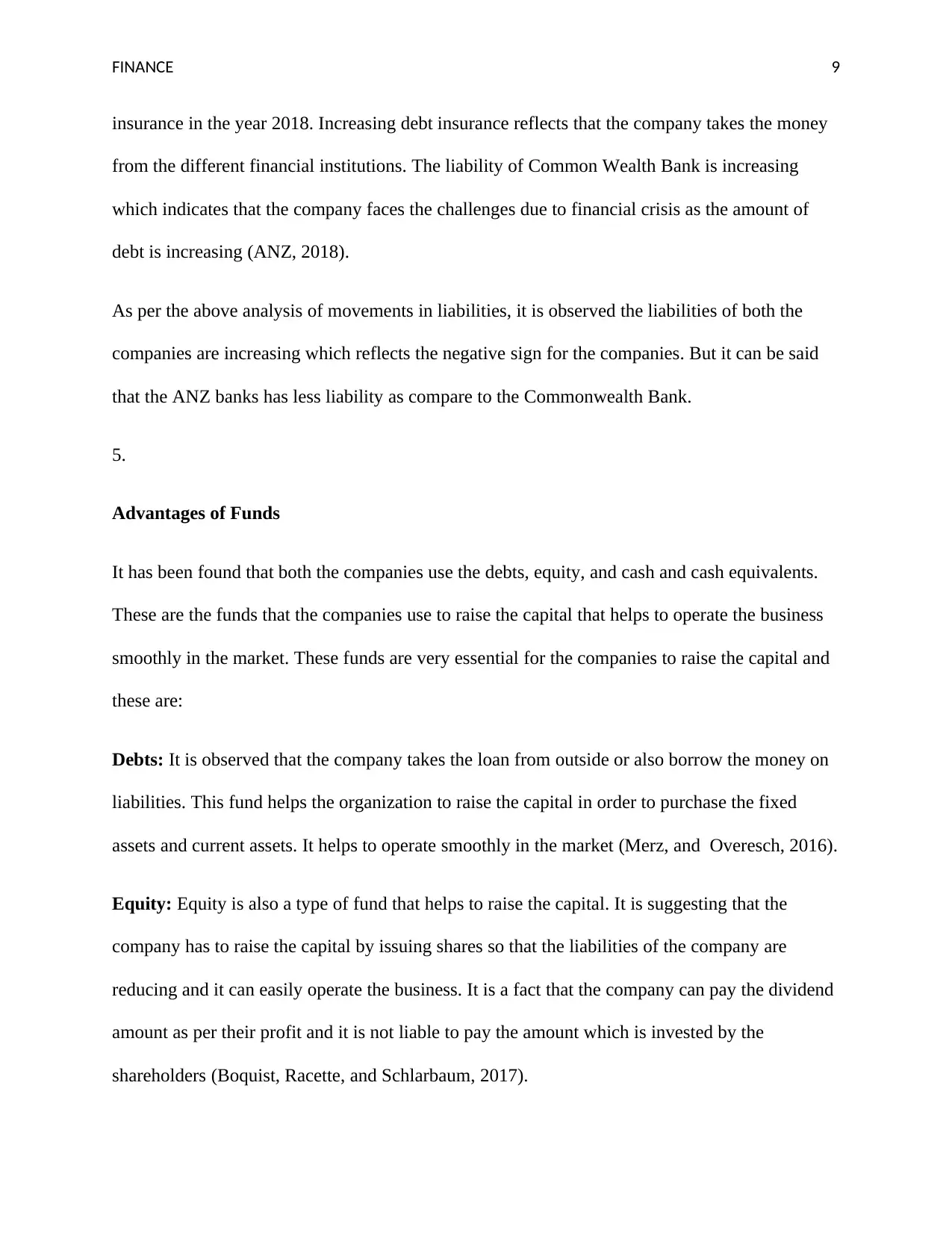
FINANCE 9
insurance in the year 2018. Increasing debt insurance reflects that the company takes the money
from the different financial institutions. The liability of Common Wealth Bank is increasing
which indicates that the company faces the challenges due to financial crisis as the amount of
debt is increasing (ANZ, 2018).
As per the above analysis of movements in liabilities, it is observed the liabilities of both the
companies are increasing which reflects the negative sign for the companies. But it can be said
that the ANZ banks has less liability as compare to the Commonwealth Bank.
5.
Advantages of Funds
It has been found that both the companies use the debts, equity, and cash and cash equivalents.
These are the funds that the companies use to raise the capital that helps to operate the business
smoothly in the market. These funds are very essential for the companies to raise the capital and
these are:
Debts: It is observed that the company takes the loan from outside or also borrow the money on
liabilities. This fund helps the organization to raise the capital in order to purchase the fixed
assets and current assets. It helps to operate smoothly in the market (Merz, and Overesch, 2016).
Equity: Equity is also a type of fund that helps to raise the capital. It is suggesting that the
company has to raise the capital by issuing shares so that the liabilities of the company are
reducing and it can easily operate the business. It is a fact that the company can pay the dividend
amount as per their profit and it is not liable to pay the amount which is invested by the
shareholders (Boquist, Racette, and Schlarbaum, 2017).
insurance in the year 2018. Increasing debt insurance reflects that the company takes the money
from the different financial institutions. The liability of Common Wealth Bank is increasing
which indicates that the company faces the challenges due to financial crisis as the amount of
debt is increasing (ANZ, 2018).
As per the above analysis of movements in liabilities, it is observed the liabilities of both the
companies are increasing which reflects the negative sign for the companies. But it can be said
that the ANZ banks has less liability as compare to the Commonwealth Bank.
5.
Advantages of Funds
It has been found that both the companies use the debts, equity, and cash and cash equivalents.
These are the funds that the companies use to raise the capital that helps to operate the business
smoothly in the market. These funds are very essential for the companies to raise the capital and
these are:
Debts: It is observed that the company takes the loan from outside or also borrow the money on
liabilities. This fund helps the organization to raise the capital in order to purchase the fixed
assets and current assets. It helps to operate smoothly in the market (Merz, and Overesch, 2016).
Equity: Equity is also a type of fund that helps to raise the capital. It is suggesting that the
company has to raise the capital by issuing shares so that the liabilities of the company are
reducing and it can easily operate the business. It is a fact that the company can pay the dividend
amount as per their profit and it is not liable to pay the amount which is invested by the
shareholders (Boquist, Racette, and Schlarbaum, 2017).
Paraphrase This Document
Need a fresh take? Get an instant paraphrase of this document with our AI Paraphraser
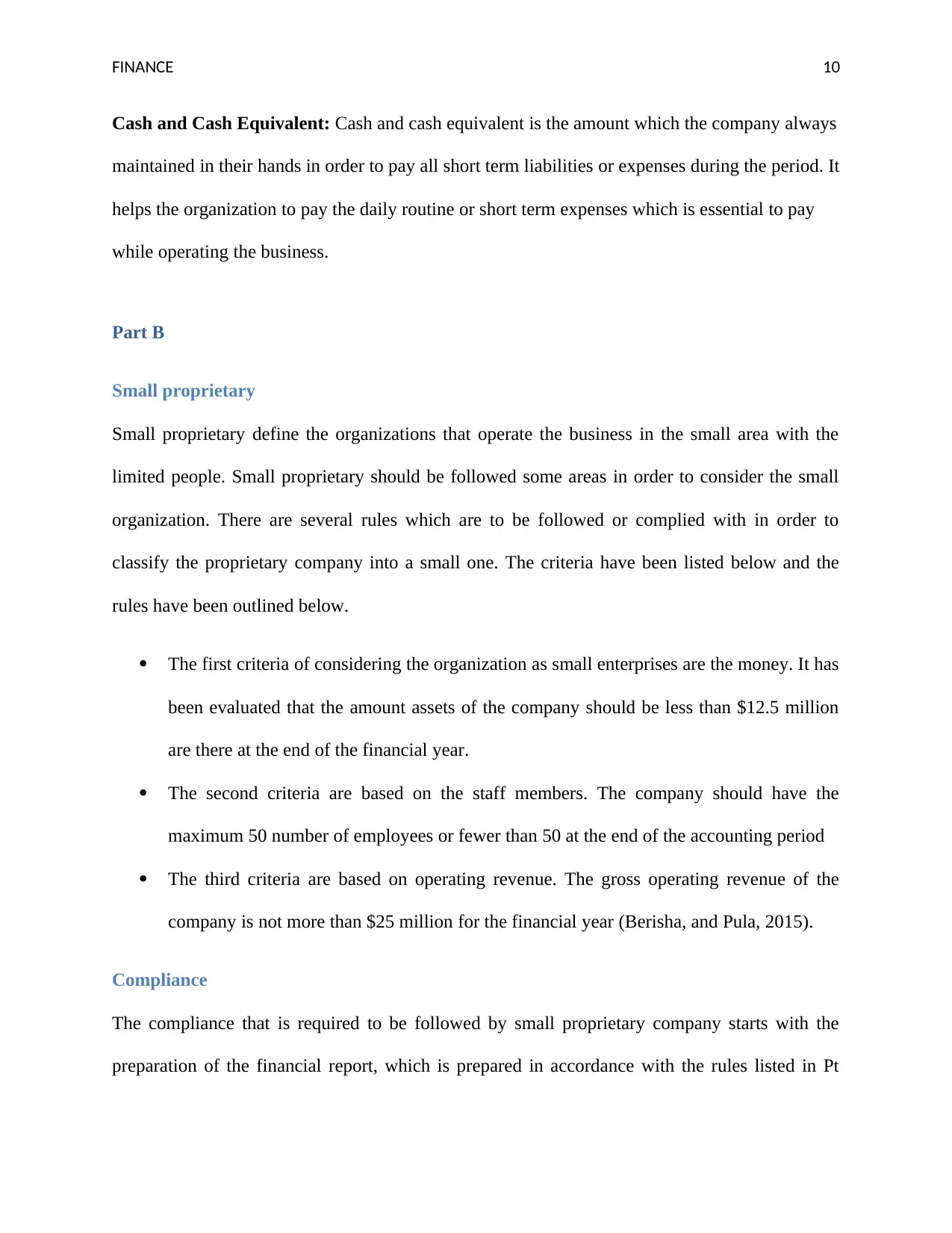
FINANCE 10
Cash and Cash Equivalent: Cash and cash equivalent is the amount which the company always
maintained in their hands in order to pay all short term liabilities or expenses during the period. It
helps the organization to pay the daily routine or short term expenses which is essential to pay
while operating the business.
Part B
Small proprietary
Small proprietary define the organizations that operate the business in the small area with the
limited people. Small proprietary should be followed some areas in order to consider the small
organization. There are several rules which are to be followed or complied with in order to
classify the proprietary company into a small one. The criteria have been listed below and the
rules have been outlined below.
The first criteria of considering the organization as small enterprises are the money. It has
been evaluated that the amount assets of the company should be less than $12.5 million
are there at the end of the financial year.
The second criteria are based on the staff members. The company should have the
maximum 50 number of employees or fewer than 50 at the end of the accounting period
The third criteria are based on operating revenue. The gross operating revenue of the
company is not more than $25 million for the financial year (Berisha, and Pula, 2015).
Compliance
The compliance that is required to be followed by small proprietary company starts with the
preparation of the financial report, which is prepared in accordance with the rules listed in Pt
Cash and Cash Equivalent: Cash and cash equivalent is the amount which the company always
maintained in their hands in order to pay all short term liabilities or expenses during the period. It
helps the organization to pay the daily routine or short term expenses which is essential to pay
while operating the business.
Part B
Small proprietary
Small proprietary define the organizations that operate the business in the small area with the
limited people. Small proprietary should be followed some areas in order to consider the small
organization. There are several rules which are to be followed or complied with in order to
classify the proprietary company into a small one. The criteria have been listed below and the
rules have been outlined below.
The first criteria of considering the organization as small enterprises are the money. It has
been evaluated that the amount assets of the company should be less than $12.5 million
are there at the end of the financial year.
The second criteria are based on the staff members. The company should have the
maximum 50 number of employees or fewer than 50 at the end of the accounting period
The third criteria are based on operating revenue. The gross operating revenue of the
company is not more than $25 million for the financial year (Berisha, and Pula, 2015).
Compliance
The compliance that is required to be followed by small proprietary company starts with the
preparation of the financial report, which is prepared in accordance with the rules listed in Pt
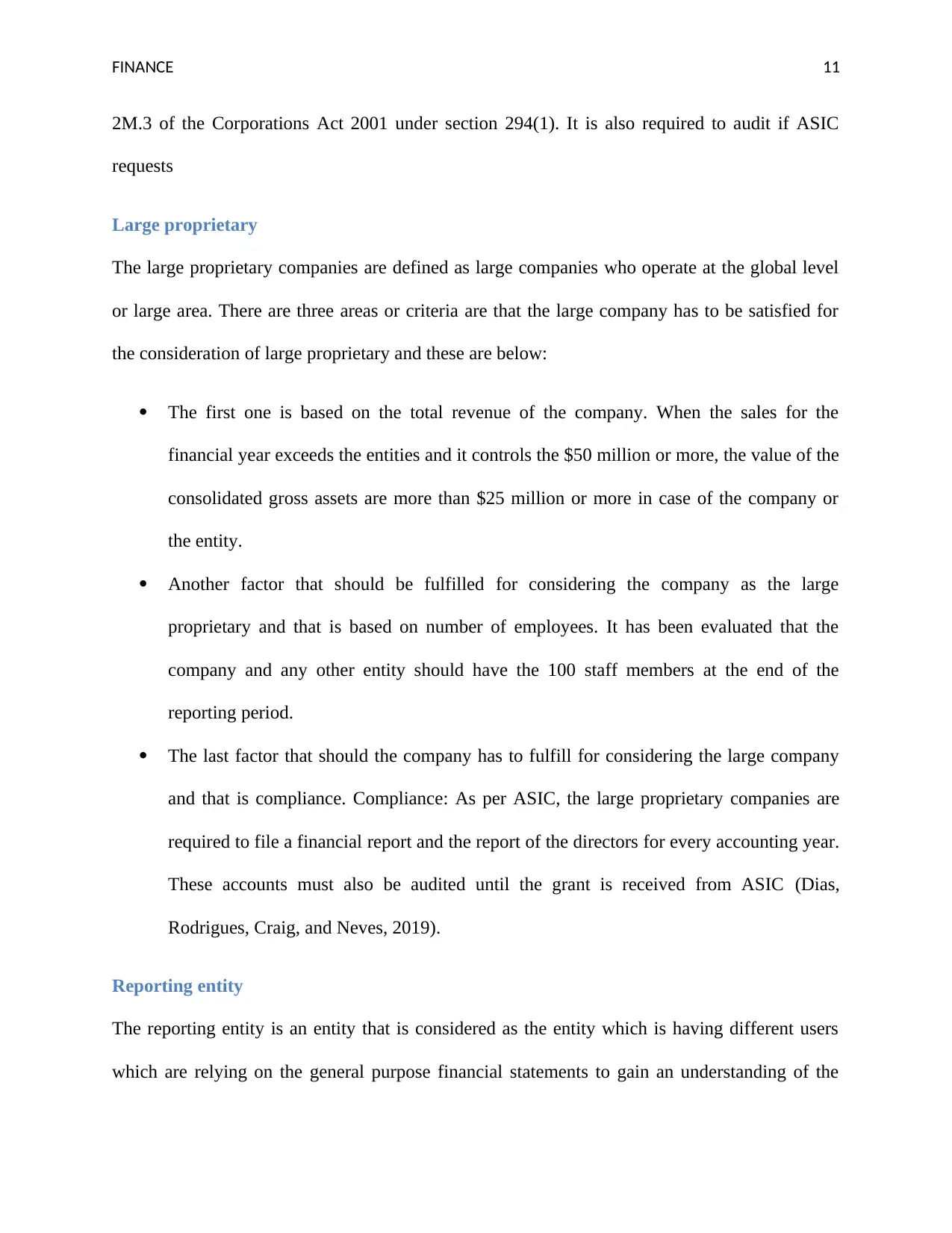
FINANCE 11
2M.3 of the Corporations Act 2001 under section 294(1). It is also required to audit if ASIC
requests
Large proprietary
The large proprietary companies are defined as large companies who operate at the global level
or large area. There are three areas or criteria are that the large company has to be satisfied for
the consideration of large proprietary and these are below:
The first one is based on the total revenue of the company. When the sales for the
financial year exceeds the entities and it controls the $50 million or more, the value of the
consolidated gross assets are more than $25 million or more in case of the company or
the entity.
Another factor that should be fulfilled for considering the company as the large
proprietary and that is based on number of employees. It has been evaluated that the
company and any other entity should have the 100 staff members at the end of the
reporting period.
The last factor that should the company has to fulfill for considering the large company
and that is compliance. Compliance: As per ASIC, the large proprietary companies are
required to file a financial report and the report of the directors for every accounting year.
These accounts must also be audited until the grant is received from ASIC (Dias,
Rodrigues, Craig, and Neves, 2019).
Reporting entity
The reporting entity is an entity that is considered as the entity which is having different users
which are relying on the general purpose financial statements to gain an understanding of the
2M.3 of the Corporations Act 2001 under section 294(1). It is also required to audit if ASIC
requests
Large proprietary
The large proprietary companies are defined as large companies who operate at the global level
or large area. There are three areas or criteria are that the large company has to be satisfied for
the consideration of large proprietary and these are below:
The first one is based on the total revenue of the company. When the sales for the
financial year exceeds the entities and it controls the $50 million or more, the value of the
consolidated gross assets are more than $25 million or more in case of the company or
the entity.
Another factor that should be fulfilled for considering the company as the large
proprietary and that is based on number of employees. It has been evaluated that the
company and any other entity should have the 100 staff members at the end of the
reporting period.
The last factor that should the company has to fulfill for considering the large company
and that is compliance. Compliance: As per ASIC, the large proprietary companies are
required to file a financial report and the report of the directors for every accounting year.
These accounts must also be audited until the grant is received from ASIC (Dias,
Rodrigues, Craig, and Neves, 2019).
Reporting entity
The reporting entity is an entity that is considered as the entity which is having different users
which are relying on the general purpose financial statements to gain an understanding of the
⊘ This is a preview!⊘
Do you want full access?
Subscribe today to unlock all pages.

Trusted by 1+ million students worldwide
1 out of 16
Related Documents
Your All-in-One AI-Powered Toolkit for Academic Success.
+13062052269
info@desklib.com
Available 24*7 on WhatsApp / Email
![[object Object]](/_next/static/media/star-bottom.7253800d.svg)
Unlock your academic potential
Copyright © 2020–2025 A2Z Services. All Rights Reserved. Developed and managed by ZUCOL.




